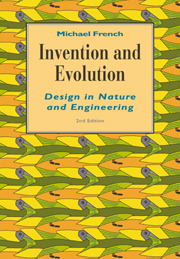Book contents
- Frontmatter
- Contents
- Preface to the second edition
- Preface to the first edition
- Acknowledgements
- 1 The designed world
- 2 Energy
- 3 Materials
- 4 Mechanism
- 5 Structures
- 6 Systems
- 7 The practice, principles and philosophy of design
- 8 Economy, form and beauty
- 9 Production, reproduction, evolution and design
- 10 Designing and inventing
- 11 Some case studies
- Questions
- Answers
- Suggestions for further reading
- Index
10 - Designing and inventing
Published online by Cambridge University Press: 06 January 2010
- Frontmatter
- Contents
- Preface to the second edition
- Preface to the first edition
- Acknowledgements
- 1 The designed world
- 2 Energy
- 3 Materials
- 4 Mechanism
- 5 Structures
- 6 Systems
- 7 The practice, principles and philosophy of design
- 8 Economy, form and beauty
- 9 Production, reproduction, evolution and design
- 10 Designing and inventing
- 11 Some case studies
- Questions
- Answers
- Suggestions for further reading
- Index
Summary
Designing and inventing
This chapter looks at the activity of functional design and inventing, the sort of people the designers and inventors are, and some aids to design and invention.
By this time, the reader should have a clear idea about what functional design is, and invention is nothing but a grander word for a particularly original or important step in design. Although invention is generally much more impressive than design, it often turns out to be the easiest part.
A recent example in which invention was rather obvious, even trivial, and all the difficulty lay in design, was the application of disc brakes to cars. The brakes on bicycles had been of this form for decades, but a great deal of ingenuity and hard work had to be put into producing a disc brake for cars that could compete with the highly-developed drum brake on favourable terms.
In affording legal protection to designers and inventors, the law makes a distinction between an invention, which can be patented, and a design, which can only be registered or copyrighted, forms of protection which can be evaded by relatively trivial changes. In general, invention is more fundamental and less specific in form and application than design, but no sharp line can be drawn between the two.
The character of inventors and designers
During the last 20 or so years there has been great interest among psychologists, educationalists and others in what they call ‘creativity’, and many quantitative studies have been made of creative people.
- Type
- Chapter
- Information
- Invention and EvolutionDesign in Nature and Engineering, pp. 283 - 321Publisher: Cambridge University PressPrint publication year: 1994

